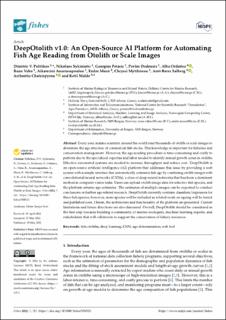| dc.contributor.author | Politikos, Dimitris V. | |
| dc.contributor.author | Sykiniotis, Nikolaos | |
| dc.contributor.author | Petasis, Georgios | |
| dc.contributor.author | Dedousis, Pavlos | |
| dc.contributor.author | Ordonez, Alba | |
| dc.contributor.author | Vabø, Rune | |
| dc.contributor.author | Anastasopoulou, Aikaterini | |
| dc.contributor.author | Moen, Endre | |
| dc.contributor.author | Mytilineou, Chryssi | |
| dc.contributor.author | Salberg, Arnt-Børre | |
| dc.contributor.author | Chatzispyrou, Archontia | |
| dc.contributor.author | Malde, Ketil | |
| dc.date.accessioned | 2022-08-11T06:58:34Z | |
| dc.date.available | 2022-08-11T06:58:34Z | |
| dc.date.created | 2022-08-09T15:36:23Z | |
| dc.date.issued | 2022-05-29 | |
| dc.identifier.issn | 2410-3888 | |
| dc.identifier.uri | https://hdl.handle.net/11250/3011198 | |
| dc.description.abstract | Every year, marine scientists around the world read thousands of otolith or scale images to determine the age structure of commercial fish stocks. This knowledge is important for fisheries and conservation management. However, the age-reading procedure is time-consuming and costly to perform due to the specialized expertise and labor needed to identify annual growth zones in otoliths. Effective automated systems are needed to increase throughput and reduce cost. DeepOtolith is an open-source artificial intelligence (AI) platform that addresses this issue by providing a web system with a simple interface that automatically estimates fish age by combining otolith images with convolutional neural networks (CNNs), a class of deep neural networks that has been a dominant method in computer vision tasks. Users can upload otolith image data for selective fish species, and the platform returns age estimates. The estimates of multiple images can be exported to conduct conclusions or further age-related research. DeepOtolith currently contains classifiers/regressors for three fish species; however, more species will be included as related work on ageing will be tested and published soon. Herein, the architecture and functionality of the platform are presented. Current limitations and future directions are also discussed. Overall, DeepOtolith should be considered as the first step towards building a community of marine ecologists, machine learning experts, and stakeholders that will collaborate to support the conservation of fishery resources. | en_US |
| dc.language.iso | eng | en_US |
| dc.publisher | MDPI | en_US |
| dc.rights | Navngivelse 4.0 Internasjonal | * |
| dc.rights.uri | http://creativecommons.org/licenses/by/4.0/deed.no | * |
| dc.title | DeepOtolith v1.0: An Open-Source AI Platform for Automating Fish Age Reading from Otolith or Scale Images | en_US |
| dc.type | Journal article | en_US |
| dc.type | Peer reviewed | en_US |
| dc.description.version | publishedVersion | en_US |
| dc.rights.holder | Copyright 2022 the authors | en_US |
| dc.source.articlenumber | 121 | en_US |
| cristin.ispublished | true | |
| cristin.fulltext | original | |
| cristin.qualitycode | 1 | |
| dc.identifier.doi | 10.3390/fishes7030121 | |
| dc.identifier.cristin | 2042034 | |
| dc.source.journal | Fishes | en_US |
| dc.relation.project | Norges forskningsråd: 270966 | en_US |
| dc.identifier.citation | Fishes. 2022, 7 (3), 121. | en_US |
| dc.source.volume | 7 | en_US |
| dc.source.issue | 3 | en_US |

